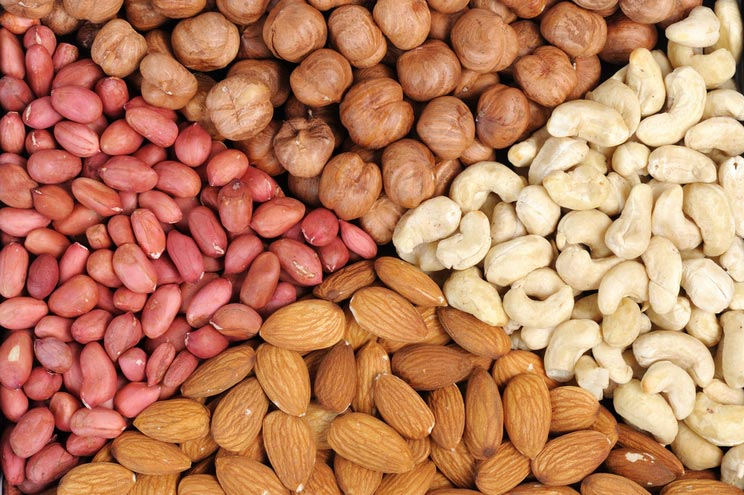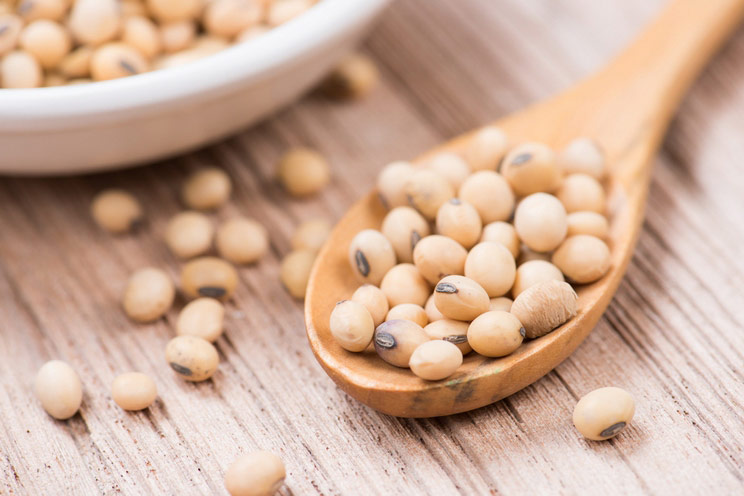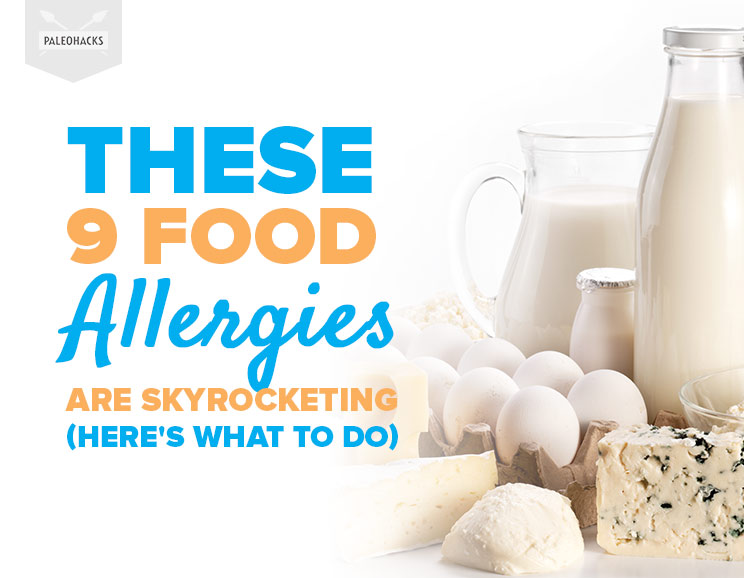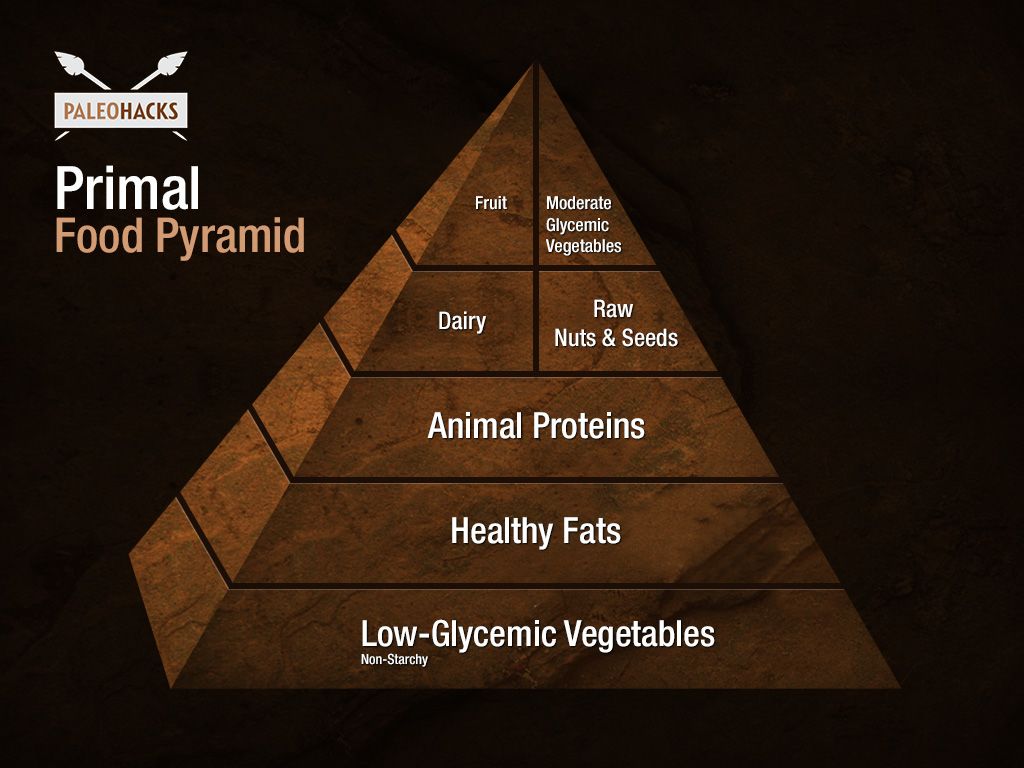If it seems like food allergies are everywhere these days, well, it’s because they are. From 1997 to 2011, food allergies among children have increased by 50 percent, with many children having more than one allergy.
An estimated 15 million Americans have food allergies, with nearly 6 million of those being younger than 18 years old. That breaks down to one in every 13 children having a diagnosable allergy to one or more foods. (1)
Why Are Food Allergies Increasing?

With the rapid increase of allergens, especially in children, it definitely makes one wonder what’s causing the epidemic of allergic food reactions. Has food changed? Have our genetics started to break down? What causes food allergies anyway?
Do you struggle with bloating, gas, constipation, or other digestive issues?
Get our FREE Guide to Healing Your Gut Naturally here!
A true food allergy is an immune response to a specific food or additive. (2) While more than 90 percent of reactions come from eight different allergens, one in particular – sesame – is on the rise, and of increasing concern. These top nine allergens are:
- Peanuts
- Tree Nuts
- Fish/Shellfish
- Coconut
- Soy
- Wheat
- Milk
- Eggs
- Sesame
Food allergy reactions don’t always have to be life-threatening, but anaphylaxis is certainly a major concern. Less severe reactions can include tingling in the mouth, itching, headache, hives, wheezing, or digestive issues.
Unfortunately, there is no solid answer as to how or why certain people become allergic to specific foods. It is more common in children, and barring anaphylactic allergies, many children have the potential to outgrow some allergens by the time they reach the age of 18. [tweet_quote]Today, the average child is allergic to approximately four foods, compared to the one or two of years past.[/tweet_quote]
While there isn’t solid data, most scientists agree that not only are the number of people with food allergies increasing, but also the average number of foods to which a single person is allergic to. Today, the average child is allergic to approximately four foods, compared to the one or two of years past. (3)
While researchers can’t agree on one solid reason as to why food allergies are dramatically increasing, theories center around several key ideas which will undoubtedly be the point of more research in the future:
- Microbiome and gut health
- Hygiene factors, such as exposure to allergens topically through broken skin or eczema
- Genetics, i.e. once a person develops an allergy for any reason, they are genetically likely to pass that on to children, even if no previous family history existed
- Environmental factors, like genetically modified foods
- Cell and genetic alterations in response to vaccinations
Bottom line: Food allergies are rising rapidly, but research can’t clearly indicate a definitive cause. As such, food allergies are a major public health concern, especially considering that children seem to be predominantly affected.
The Top 9 Food Allergens
While there are more than 170 documented food allergens, most reactions are due to nine specific foods. (4)
1. Peanuts

The most talked about allergy, peanuts, have gained their reputation for typically producing severe anaphylactic reactions in those who have true IgE allergies to these common legumes. Most people who have a peanut allergy will carry an epinephrine auto-injector, which can provide life-saving treatment in case of exposure.
How to Address a Peanut Allergy
For most with these allergies, strict avoidance of peanuts and any products containing peanut ingredients is essential. Severe reactions can occur even with mild cross contamination, such as eating a food produced in a facility that also handles peanuts or touching someone who has eaten a peanut food.
Most peanut allergies are lifelong, and children or adults who develop them don’t typically outgrow them, although 20 percent of children with peanut allergies might outgrow them or downgrade the severity of their reaction to exposures. (5)
Recent research indicates that as many as 40 percent of those who have peanut allergies will also have tree nut allergies. (6)
2. Tree Nuts

Tree nuts can be as severe as peanut allergies, and like peanut allergies, they tend to be lifelong, although a recent study showed that about nine percent of children with tree nut allergies will outgrow them by the time they reach adulthood. (7)
The most common tree nut allergens include: (8)
- Walnuts
- Almonds
- Hazelnuts
- Cashews
- Pistachios
- Brazil nuts
How to Address a Tree Nut Allergy
Individuals with tree nut allergies must avoid topical sources of these as well, including body oils, lotions, hair care products, and soaps. It’s important to note that coconut, nutmeg, water chestnuts, and butternut squash are not tree nuts, and do not need to be avoided by those with tree nut allergies, although coconuts can also cause their own allergic reactions.
3. Coconut

Coconut allergies aren’t nearly as common as peanuts or tree nuts, but those who do have them can experience a wide range of allergic reactions, including rare cases of anaphylaxis. (9)
While coconuts are not tree nuts or legumes, they are members of the palm family. In some cases, people with a coconut allergy will also be allergic to tree nuts or peanuts, or both.
How to Address a Coconut Allergy
People with coconut allergies need to avoid all coconut products, including oils and topical products that contain coconut oil. They should also take care to avoid peanuts and/or tree nuts if an allergy for either of those is present.
Coconut products are becoming increasingly popular in both foods and personal care products, so it’s important to thoroughly read labels.
4. Shellfish

Shellfish allergens are one of the few food allergies that are more common in adults than in children, and they can worsen over time.
Fish that are included in shellfish reactions are:
- Clams
- Crabs
- Crawfish
- Lobsters
- Mussels
- Octopus
- Oysters
- Scallops
- Shrimp
- Squid
How to Address a Shellfish Allergy
As with most true allergies, the best way to avoid reactions is to avoid all contact and cross contamination. (10) This can mean that highly allergic individuals must avoid restaurants that prepare any form of shellfish, since cross contamination can present serious reactions.
While the shellfish listed above can all be reactive, people with shellfish allergies aren’t necessarily allergic to all fish, such as salmon or tuna. Those types of fish are entirely different in composition and are not top allergens.
5. Soy

Soybeans are legumes, and while they’re in the same family as peanuts, the two allergies aren’t always linked. Soy allergies are most common in babies and children, but most will outgrow them by age ten. (11) Anaphylaxis reactions to soy are rare.
How to Address a Soy Allergy
Soy is often found in infant formulas, whether in the form of protein or preservative (as soy lecithin), which might explain the frequency of infant and childhood soy allergies. Soy lecithin, soybean oil, and soy flour are found in most commercially produced food products, even natural and organic ones.
Truly allergic individuals need to vigilantly read labels and avoid any type of soy product. This can lead to essentially ridding the diet of most processed and packaged foods. Individuals with soy allergies tend to thrive well on a Paleo diet, which eliminates soy and processed foods anyway.
6. Wheat

Wheat is a common childhood allergy, and in some cases, can be outgrown before reaching adulthood. (12) Wheat allergy is rarely anaphylactic, but in some cases it can be.
Wheat allergy and celiac disease are different reactions entirely. A wheat allergy is an immune response to the protein found in the grain, whereas celiac disease is a small intestinal reaction to gluten that causes severe damage to the digestive tract. Both involve the immune system, but in celiac disease, most of the reactive damage takes place in the digestive system only, whereas a wheat allergy can immediately have a whole body reaction.
How to Address a Wheat Allergy
Wheat products are found in many processed foods, and cross-reactive wheat products include barley, rye, and many other grains that have contact with wheat during the manufacturing process.
Thankfully, in today’s gluten-free friendly society, it’s easy to swap wheat products for safe ones. Paleo flours, such as cassava and almond, replace wheat flour in recipes one-for-one. If a nut allergy is also present, almond should be avoided, but cassava is type of root vegetable that doesn’t contain any top allergens and is safe for most allergic individuals.
Many sauces contain hidden sources of wheat, so when a wheat allergy is present, it’s best to make most things at home from scratch. Tapioca and arrowroot powders work perfectly to thicken sauces, and are both gluten-free and Paleo.
7. Cow’s Milk

Cow’s milk allergy is one of the most common allergies in infants and young children. (13) A cow’s milk allergy is different from lactose intolerance. Lactose intolerance involves difficulty digesting lactose and usually results in digestive upset and less severe symptoms, whereas a true dairy allergy can result in hives, skin problems, severe constipation, and in rare cases, anaphylaxis.
Cow’s milk allergies can be measured by antibodies in the blood. Even those with measurable antibodies can outgrow an allergy at some point, as individual sensitivity varies person to person. (14)
How to Address a Cow’s Milk Allergy
Strict avoidance of cow’s milk and all related products is important – including yogurt, kefir, and butter. Ghee is typically an exception, even for those allergic to cow’s milk, since it contains no lactose or milk protein, but just milk fat. Still, it may produce reactions in allergic individuals so this is a very case-by-case decision.
Milk can be replaced with alternative versions like almond milk, cashew milk, or coconut milk. If tree nut and coconut allergens are an issue, hemp milk is an allergy-friendly alternative that is gaining popularity.
Butter and ghee can be swapped with avocado oil, lard, tallow, or olive oil.
It’s not as difficult these days to live a dairy-free life, and there are even viable cheese replacements with cashew cheese.
8. Eggs

Eggs are one of the most common childhood allergens and can cause a wide range of symptoms and reactions. (15) While allergens are typically in response to the white of the egg, most dealing with allergies will need to avoid yolks, too. (16) Typical allergic reactions to eggs can range from hives to skin issues, to rarer cases of anaphylaxis.
In rare cases, children with egg allergies can be susceptible to cross contact and reactions from non-food sources, like certain vaccines that contain egg protein, although not all egg-allergic children will have these types of reactions. Some children can tolerate eggs in baked goods, where others will need to strictly avoid eggs entirely.
How to Address an Egg Allergy
Living an egg-free life doesn’t have to be restrictive, as there are a number of egg replacers for baking that are just as effective. While using an egg substitute for something like a frittata won’t work, egg-free breakfast options are abundant. In the Paleo world, breakfast can be just as rich and savory without eggs, especially with dishes like Hemp Seed Oatmeal or No-Bake Sweet Potato Donuts.
9. Sesame

While seed allergies are not as common as those in the top eight, sesame allergies are on the rise and an increasing concern. Sesame seeds have the potential for severe reactions, including anaphylaxis. Research indicates that in some cases, the first sign of a sesame allergy can be immediate anaphylaxis, making it potentially more dangerous than several other allergens. (17)
One of the biggest rising concerns over sesame is that it appears to have high cross-reactivity with both peanut and tree nut allergies. (18) In children with peanut allergies, sesame allergies occur 13 percent of the time; in tree nut allergic children, sesame occurs nearly 15 percent of the time; and in children with both peanut and tree nut allergies, sesame allergies can occur as much as 50 percent of the time. (19)
How to Address a Sesame Allergy
Sesame is often found in gluten-free granola or grain blends, in Asian foods (even gluten-free ones), in hummus, and in many other processed foods. When eating at restaurants with sesame allergic individuals, it’s typically best to avoid restaurants that use sesame broadly in their dishes.
Bottom line: Food allergies are serious immune responses to foods. While more than a hundred food allergens exist, most severe reactions come from these nine foods. Learning to live with one or more food allergies can feel overwhelming, especially for parents who find out that their small children have life-threatening allergies. Awareness and education are the greatest tools to ensure food safety around allergic individuals.
Should Small Children Avoid or Get Early Introduction to Avoid Severe Allergies?

While there have been mixed viewpoints from experts, the most recently accepted theory is that early introduction of top allergens by ingesting small amounts could help to prevent the development of allergy. What could be problematic, however, is topical exposure to allergenic foods, especially through broken skin (like cuts or eczema). (20)
Children who have food allergies are as much as four times more likely to have other conditions related with allergies (like asthma, skin conditions, and seasonal allergies), than children who have no food allergies. (21) [tweet_quote]The most important way to determine how to introduce allergenic foods to your child is to speak to their pediatrician.[/tweet_quote]
The most important way to determine how to introduce allergenic foods to your child is to speak to their pediatrician. Recommendations could change based on family history (i.e. whether you or someone else in your family has an IgE food allergy), the health of the child (presence of eczema, colic, or other similar issues that could be linked to allergic reactions), and their exposures to gut-altering things like antibiotics and NSAIDs, which can alter the way that the immune system responds.
Bottom line: Introducing food allergens to children for the first time can be scary, especially given that food allergies are increasing rapidly. Speak to your child’s doctor for a customized approach as there is currently no “one size fits all” method.

(Read This Next: Gut Health and Food Allergies (Plus: 14 Easy Paleo Foods Swaps for Kids))



 Ciabatta Bread Recipe (Gluten Free, Grain Free)
Ciabatta Bread Recipe (Gluten Free, Grain Free)









Show Comments